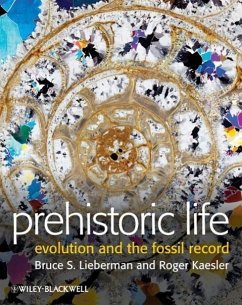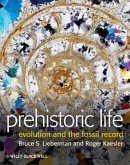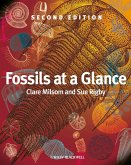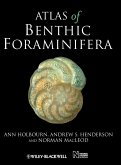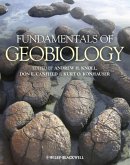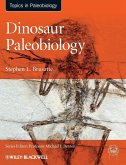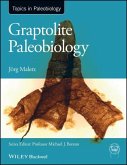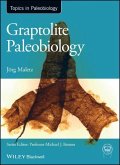- Gebundenes Buch
- Merkliste
- Auf die Merkliste
- Bewerten Bewerten
- Teilen
- Produkt teilen
- Produkterinnerung
- Produkterinnerung
Prehistoric life is the archive of evolution preserved in thefossil record. This book focuses on the meaning andsignificance of that archive and is designed for introductorycollege science students, including non-science majors, enrolled insurvey courses emphasizing paleontology, geology and biology.
From the origins of animals to the evolution of rap music, fromancient mass extinctions to the current biodiversity crisis, andfrom the Snowball Earth to present day climate change this bookcovers it, with an eye towards showing how past life on Earth putsthe modern world into its proper…mehr
Andere Kunden interessierten sich auch für
![Prehistoric Life Prehistoric Life]() Bruce S. LiebermanPrehistoric Life108,99 €
Bruce S. LiebermanPrehistoric Life108,99 €![Fossils at a Glance Fossils at a Glance]() Clare MilsomFossils at a Glance64,99 €
Clare MilsomFossils at a Glance64,99 €![Atlas of Benthic Foraminifera Atlas of Benthic Foraminifera]() Ann HolbournAtlas of Benthic Foraminifera222,99 €
Ann HolbournAtlas of Benthic Foraminifera222,99 €![Fundamentals of Geobiology Fundamentals of Geobiology]() Fundamentals of Geobiology96,99 €
Fundamentals of Geobiology96,99 €![Dinosaur Paleobiology Dinosaur Paleobiology]() Stephen L. BrusatteDinosaur Paleobiology96,99 €
Stephen L. BrusatteDinosaur Paleobiology96,99 €![Graptolite Paleobiology Graptolite Paleobiology]() Jörg MaletzGraptolite Paleobiology52,99 €
Jörg MaletzGraptolite Paleobiology52,99 €![Graptolite Paleobiology Graptolite Paleobiology]() Jörg MaletzGraptolite Paleobiology150,99 €
Jörg MaletzGraptolite Paleobiology150,99 €-
-
-
Prehistoric life is the archive of evolution preserved in thefossil record. This book focuses on the meaning andsignificance of that archive and is designed for introductorycollege science students, including non-science majors, enrolled insurvey courses emphasizing paleontology, geology and biology.
From the origins of animals to the evolution of rap music, fromancient mass extinctions to the current biodiversity crisis, andfrom the Snowball Earth to present day climate change this bookcovers it, with an eye towards showing how past life on Earth putsthe modern world into its proper context. The history of life andthe patterns and processes of evolution are especially emphasized,as are the interconnections between our planet, its climate system,and its varied life forms. The book does not just describe thehistory of life, but uses actual examples from life's historyto illustrate important concepts and theories.
From the origins of animals to the evolution of rap music, fromancient mass extinctions to the current biodiversity crisis, andfrom the Snowball Earth to present day climate change this bookcovers it, with an eye towards showing how past life on Earth putsthe modern world into its proper context. The history of life andthe patterns and processes of evolution are especially emphasized,as are the interconnections between our planet, its climate system,and its varied life forms. The book does not just describe thehistory of life, but uses actual examples from life's historyto illustrate important concepts and theories.
Produktdetails
- Produktdetails
- Verlag: Wiley & Sons
- 1. Auflage
- Seitenzahl: 400
- Erscheinungstermin: 22. März 2010
- Englisch
- Abmessung: 284mm x 222mm x 27mm
- Gewicht: 1449g
- ISBN-13: 9781444334081
- ISBN-10: 1444334085
- Artikelnr.: 28707818
- Herstellerkennzeichnung
- Libri GmbH
- Europaallee 1
- 36244 Bad Hersfeld
- gpsr@libri.de
- Verlag: Wiley & Sons
- 1. Auflage
- Seitenzahl: 400
- Erscheinungstermin: 22. März 2010
- Englisch
- Abmessung: 284mm x 222mm x 27mm
- Gewicht: 1449g
- ISBN-13: 9781444334081
- ISBN-10: 1444334085
- Artikelnr.: 28707818
- Herstellerkennzeichnung
- Libri GmbH
- Europaallee 1
- 36244 Bad Hersfeld
- gpsr@libri.de
Bruce S. Lieberman is a Professor in the Department of Geology and a Senior Curator of Invertebrate Paleontology in the Natural History Museum/Biodiversity Research Center (NHM/BRC) at the University of Kansas (KU), U.S.A. His research focuses on the study of evolution in the fossil record, including the origin of animals, macroevolutionary theory, and biogeography. Roger L. Kaesler passed away in 2007. He was Director of the Paleontological Institute as well as a Professor in the Department of Geology and a Senior Curator of Invertebrate Paleontology in the NHM/BRC at KU. His research focused on paleoecology and fossil arthropods.
Preface.
1. Introduction to Fossils.
History, Science, and Historical Science.
Time, Life, and Stratigraphy.
What is a Fossil?.
How do Fossils Form?.
Conclusions: Fossils as Curious Stones.
Additional Reading.
2. The Nature of the Fossil Record.
Fossils in Sedimentary Rock.
Taphonomy.
Time Averaging.
Mode of Growth.
Colonial Organisms.
Trace Fossils.
Concluding Remarks.
Additional Reading.
3. Organizing the Fossil Record.
History of Ideas on Biological Classification.
Applying Linnaeus' Hierarchy.
What is a Species and How Does a Paleontologist Identify Them?.
Conclusions: the Difference Between Inanimate Atoms and Living Things.
Additional Reading.
4. Introduction to Evolution.
Introduction.
A Biological Definition of Evolution.
The History of Evolutionary Thought.
Science and Religion.
Darwin and Wallace: Never Ask a Stranger to Present Your Paper at a Meeting
You Cannot Attend.
Natural Selection.
Conclusions: Why was Natural Selection Not Endorsed at Once by Many
Scientists?.
Additional Reading.
5. Macroevolution, Progress, and the History of Life.
Introduction.
Competition and Macroevolution.
Does Evolution Happen Gradually or Episodically?.
Natural Selection Operating Above and Below the Level of the Individual
Organism.
Progress and the History of Life.
Conclusions: Patterns and Processes of Increasing Complexity.
Additional Reading.
6. Extinctions: The Legacy of the Fossil Record.
Introduction.
Contingency.
Boundaries in the Geological Time Scale and the Nature of Extinction.
The Cretaceous-Tertiary Mass Extinction.
How has the Existence of Mass Extinctions Influenced the History of Life?.
Were Most Extinctions Caused by Asteroid Impact?.
The Permo-Triassic Mass Extinction-Causes and Consequences.
The Ordovician-Silurian Mass Extinction.
Other Mass Extinction Events: The Late Devonian and the End of the
Triassic.
Habitat Degradation and Mass Extinctions.
The Sixth Great Mass Extinction: The Current Biodiversity Crisis.
Conclusions: Lessons from the Past and Future Prospects for Humanity.
Additional Reading.
7. Systematics and the Fossil Record.
Introduction.
Methods and Approaches in Systematics.
The Growth of Molecular Biology and Improvements in DNA Sequencing
Technology.
The Spread of Computers and Computer Programs Used to Study Evolutionary
Relationships.
Systematics and How to go About Identifying Species in the Fossil Record.
Systematics and its Relevance for Identifying Patterns of Mass Extinction.
Systematics and the Meaning of Adaptations.
Concluding Remarks.
Additional Reading.
8. Principles of Growth and Form: Life, the Universe, and Gothic
Cathedrals.
Introduction.
Galileo's Principle.
Galileo's Principle and its Relevance to the Biology of Living Organisms.
Galileo's Principle and Constraints on the Evolution of Large Body Size.
Galileo's Principle and its Relevance to Medieval Architecture.
Galileo's Principle and its Relevance to Cratering Density in our Solar
System.
Concluding Remarks.
Additional Reading.
9. The Role of Fossils in the Genesis of Myths and Legends.
Introduction.
Paleontologist's Have Come from Many Different Walks of Life and Have
Sported Many Different Hairdos.
Paleontology in Ancient Greece.
Native American Contributions to Paleontology.
Concluding Remarks.
Additional Reading.
10. Plate Tectonics and its Effects on Evolution.
Introduction.
Early Ideas on Continents in Motion: Continental Drift.
Plate Tectonics: Continental Drift in a Different Guise and with a Valid
Mechanism.
The Evolutionary Implications of Plate Tectonics.
Biogeography.
Concluding Remarks.
Additional Reading.
11. Life, Climate, and Geology.
Introduction.
Some of the Major Factors that Govern the Climate System.
Examples of How Life has Influenced Climate: The Difference Between the
Proterozoic and the Permian.
Life Influencing Geology: the Form and Shape of Rivers and the Rocks they
Leave Behind.
Plants, Oxygen, and Coal: More Examples of Life Affecting the Atmosphere
and Geology.
How Geology Affects Climate: Considering How Plate Tectonic Changes have
Contributed to Climate Changes Over the Last 60 Million Years.
Concluding Remarks.
Additional Reading.
12. Patterns and Processes of Precambrian Evolution.
Introduction.
The Earliest Evidence for Life in the Geological Record.
The Time of Pond Scum and the Rise of Oxygen.
For Billions of Years Organisms Have Been Modifying the Atmosphere and
Their Environment.
More Effects of Rising Oxygen Levels.
The Evolution of the Eukaryotic Cell.
Concluding Remarks.
Additional Reading.
13. The Cambrian Radiation and Beyond: Understanding Biology's Big Bang.
Introduction.
Life Before the Cambrian Radiation.
The Burgess Shale and the Cambrian Radiation.
The Ordovician Radiation and Concluding.
Remarks.
Additional Reading.
14. The Evolution and Extinction of Reefs Through Time: From the
Precambrian to the Current Biodiversity Crisis.
Introduction.
Reef-Forming Organisms Today.
Cnidarians and Outer Space.
How Modern Cnidarian Corals Feed.
Reefs Through Geological Time.
Corals and the Biodiversity Crisis.
Lessons from Human Effects on Modern Reefs.
Concluding Remarks.
Additional Reading.
15. Key Evolutionary Transitions: The Origins of Multicellularity and the
Evolution of the Vertebrate Brain.
Introduction.
Origins of Multicellularity.
The Evolution of the Vertebrate Brain.
Trends in Brain Size Within Primates and.
Hominids.
Concluding Remarks.
Additional Reading.
16. Key Events in Vertebrate Evolution.
Introduction.
Cambrian Origins.
Major Groups of Chordates.
The Vertebrates.
Lobe-Finned Aquatic Vertebrates.
The Origins and Evolution of the Tetrapods.
Concluding Remarks.
Additional Reading.
17. Are We Alone in the Universe?.
Introduction.
What is the Potential that Humans will Encounter Extraterrestrial
Civilizations?.
Radio Waves and the Search for Extra-Terrestrial Intelligence.
Possible Evidence for Life in a Martian Meteorite?.
Concluding Remarks.
Additional Reading.
18. Humanity: Origins and Prospects.
Introduction.
How do New Species Evolve-The Shift from Chimps to Hominids.
Humans in a Changing Climate.
The Current Biodiversity Crisis.
Mapping a Course for Future Changes-Climate and Life.
Concluding Remarks.
Additional Reading.
Color plate section.
Index.
1. Introduction to Fossils.
History, Science, and Historical Science.
Time, Life, and Stratigraphy.
What is a Fossil?.
How do Fossils Form?.
Conclusions: Fossils as Curious Stones.
Additional Reading.
2. The Nature of the Fossil Record.
Fossils in Sedimentary Rock.
Taphonomy.
Time Averaging.
Mode of Growth.
Colonial Organisms.
Trace Fossils.
Concluding Remarks.
Additional Reading.
3. Organizing the Fossil Record.
History of Ideas on Biological Classification.
Applying Linnaeus' Hierarchy.
What is a Species and How Does a Paleontologist Identify Them?.
Conclusions: the Difference Between Inanimate Atoms and Living Things.
Additional Reading.
4. Introduction to Evolution.
Introduction.
A Biological Definition of Evolution.
The History of Evolutionary Thought.
Science and Religion.
Darwin and Wallace: Never Ask a Stranger to Present Your Paper at a Meeting
You Cannot Attend.
Natural Selection.
Conclusions: Why was Natural Selection Not Endorsed at Once by Many
Scientists?.
Additional Reading.
5. Macroevolution, Progress, and the History of Life.
Introduction.
Competition and Macroevolution.
Does Evolution Happen Gradually or Episodically?.
Natural Selection Operating Above and Below the Level of the Individual
Organism.
Progress and the History of Life.
Conclusions: Patterns and Processes of Increasing Complexity.
Additional Reading.
6. Extinctions: The Legacy of the Fossil Record.
Introduction.
Contingency.
Boundaries in the Geological Time Scale and the Nature of Extinction.
The Cretaceous-Tertiary Mass Extinction.
How has the Existence of Mass Extinctions Influenced the History of Life?.
Were Most Extinctions Caused by Asteroid Impact?.
The Permo-Triassic Mass Extinction-Causes and Consequences.
The Ordovician-Silurian Mass Extinction.
Other Mass Extinction Events: The Late Devonian and the End of the
Triassic.
Habitat Degradation and Mass Extinctions.
The Sixth Great Mass Extinction: The Current Biodiversity Crisis.
Conclusions: Lessons from the Past and Future Prospects for Humanity.
Additional Reading.
7. Systematics and the Fossil Record.
Introduction.
Methods and Approaches in Systematics.
The Growth of Molecular Biology and Improvements in DNA Sequencing
Technology.
The Spread of Computers and Computer Programs Used to Study Evolutionary
Relationships.
Systematics and How to go About Identifying Species in the Fossil Record.
Systematics and its Relevance for Identifying Patterns of Mass Extinction.
Systematics and the Meaning of Adaptations.
Concluding Remarks.
Additional Reading.
8. Principles of Growth and Form: Life, the Universe, and Gothic
Cathedrals.
Introduction.
Galileo's Principle.
Galileo's Principle and its Relevance to the Biology of Living Organisms.
Galileo's Principle and Constraints on the Evolution of Large Body Size.
Galileo's Principle and its Relevance to Medieval Architecture.
Galileo's Principle and its Relevance to Cratering Density in our Solar
System.
Concluding Remarks.
Additional Reading.
9. The Role of Fossils in the Genesis of Myths and Legends.
Introduction.
Paleontologist's Have Come from Many Different Walks of Life and Have
Sported Many Different Hairdos.
Paleontology in Ancient Greece.
Native American Contributions to Paleontology.
Concluding Remarks.
Additional Reading.
10. Plate Tectonics and its Effects on Evolution.
Introduction.
Early Ideas on Continents in Motion: Continental Drift.
Plate Tectonics: Continental Drift in a Different Guise and with a Valid
Mechanism.
The Evolutionary Implications of Plate Tectonics.
Biogeography.
Concluding Remarks.
Additional Reading.
11. Life, Climate, and Geology.
Introduction.
Some of the Major Factors that Govern the Climate System.
Examples of How Life has Influenced Climate: The Difference Between the
Proterozoic and the Permian.
Life Influencing Geology: the Form and Shape of Rivers and the Rocks they
Leave Behind.
Plants, Oxygen, and Coal: More Examples of Life Affecting the Atmosphere
and Geology.
How Geology Affects Climate: Considering How Plate Tectonic Changes have
Contributed to Climate Changes Over the Last 60 Million Years.
Concluding Remarks.
Additional Reading.
12. Patterns and Processes of Precambrian Evolution.
Introduction.
The Earliest Evidence for Life in the Geological Record.
The Time of Pond Scum and the Rise of Oxygen.
For Billions of Years Organisms Have Been Modifying the Atmosphere and
Their Environment.
More Effects of Rising Oxygen Levels.
The Evolution of the Eukaryotic Cell.
Concluding Remarks.
Additional Reading.
13. The Cambrian Radiation and Beyond: Understanding Biology's Big Bang.
Introduction.
Life Before the Cambrian Radiation.
The Burgess Shale and the Cambrian Radiation.
The Ordovician Radiation and Concluding.
Remarks.
Additional Reading.
14. The Evolution and Extinction of Reefs Through Time: From the
Precambrian to the Current Biodiversity Crisis.
Introduction.
Reef-Forming Organisms Today.
Cnidarians and Outer Space.
How Modern Cnidarian Corals Feed.
Reefs Through Geological Time.
Corals and the Biodiversity Crisis.
Lessons from Human Effects on Modern Reefs.
Concluding Remarks.
Additional Reading.
15. Key Evolutionary Transitions: The Origins of Multicellularity and the
Evolution of the Vertebrate Brain.
Introduction.
Origins of Multicellularity.
The Evolution of the Vertebrate Brain.
Trends in Brain Size Within Primates and.
Hominids.
Concluding Remarks.
Additional Reading.
16. Key Events in Vertebrate Evolution.
Introduction.
Cambrian Origins.
Major Groups of Chordates.
The Vertebrates.
Lobe-Finned Aquatic Vertebrates.
The Origins and Evolution of the Tetrapods.
Concluding Remarks.
Additional Reading.
17. Are We Alone in the Universe?.
Introduction.
What is the Potential that Humans will Encounter Extraterrestrial
Civilizations?.
Radio Waves and the Search for Extra-Terrestrial Intelligence.
Possible Evidence for Life in a Martian Meteorite?.
Concluding Remarks.
Additional Reading.
18. Humanity: Origins and Prospects.
Introduction.
How do New Species Evolve-The Shift from Chimps to Hominids.
Humans in a Changing Climate.
The Current Biodiversity Crisis.
Mapping a Course for Future Changes-Climate and Life.
Concluding Remarks.
Additional Reading.
Color plate section.
Index.
Preface.
1. Introduction to Fossils.
History, Science, and Historical Science.
Time, Life, and Stratigraphy.
What is a Fossil?.
How do Fossils Form?.
Conclusions: Fossils as Curious Stones.
Additional Reading.
2. The Nature of the Fossil Record.
Fossils in Sedimentary Rock.
Taphonomy.
Time Averaging.
Mode of Growth.
Colonial Organisms.
Trace Fossils.
Concluding Remarks.
Additional Reading.
3. Organizing the Fossil Record.
History of Ideas on Biological Classification.
Applying Linnaeus' Hierarchy.
What is a Species and How Does a Paleontologist Identify Them?.
Conclusions: the Difference Between Inanimate Atoms and Living Things.
Additional Reading.
4. Introduction to Evolution.
Introduction.
A Biological Definition of Evolution.
The History of Evolutionary Thought.
Science and Religion.
Darwin and Wallace: Never Ask a Stranger to Present Your Paper at a Meeting
You Cannot Attend.
Natural Selection.
Conclusions: Why was Natural Selection Not Endorsed at Once by Many
Scientists?.
Additional Reading.
5. Macroevolution, Progress, and the History of Life.
Introduction.
Competition and Macroevolution.
Does Evolution Happen Gradually or Episodically?.
Natural Selection Operating Above and Below the Level of the Individual
Organism.
Progress and the History of Life.
Conclusions: Patterns and Processes of Increasing Complexity.
Additional Reading.
6. Extinctions: The Legacy of the Fossil Record.
Introduction.
Contingency.
Boundaries in the Geological Time Scale and the Nature of Extinction.
The Cretaceous-Tertiary Mass Extinction.
How has the Existence of Mass Extinctions Influenced the History of Life?.
Were Most Extinctions Caused by Asteroid Impact?.
The Permo-Triassic Mass Extinction-Causes and Consequences.
The Ordovician-Silurian Mass Extinction.
Other Mass Extinction Events: The Late Devonian and the End of the
Triassic.
Habitat Degradation and Mass Extinctions.
The Sixth Great Mass Extinction: The Current Biodiversity Crisis.
Conclusions: Lessons from the Past and Future Prospects for Humanity.
Additional Reading.
7. Systematics and the Fossil Record.
Introduction.
Methods and Approaches in Systematics.
The Growth of Molecular Biology and Improvements in DNA Sequencing
Technology.
The Spread of Computers and Computer Programs Used to Study Evolutionary
Relationships.
Systematics and How to go About Identifying Species in the Fossil Record.
Systematics and its Relevance for Identifying Patterns of Mass Extinction.
Systematics and the Meaning of Adaptations.
Concluding Remarks.
Additional Reading.
8. Principles of Growth and Form: Life, the Universe, and Gothic
Cathedrals.
Introduction.
Galileo's Principle.
Galileo's Principle and its Relevance to the Biology of Living Organisms.
Galileo's Principle and Constraints on the Evolution of Large Body Size.
Galileo's Principle and its Relevance to Medieval Architecture.
Galileo's Principle and its Relevance to Cratering Density in our Solar
System.
Concluding Remarks.
Additional Reading.
9. The Role of Fossils in the Genesis of Myths and Legends.
Introduction.
Paleontologist's Have Come from Many Different Walks of Life and Have
Sported Many Different Hairdos.
Paleontology in Ancient Greece.
Native American Contributions to Paleontology.
Concluding Remarks.
Additional Reading.
10. Plate Tectonics and its Effects on Evolution.
Introduction.
Early Ideas on Continents in Motion: Continental Drift.
Plate Tectonics: Continental Drift in a Different Guise and with a Valid
Mechanism.
The Evolutionary Implications of Plate Tectonics.
Biogeography.
Concluding Remarks.
Additional Reading.
11. Life, Climate, and Geology.
Introduction.
Some of the Major Factors that Govern the Climate System.
Examples of How Life has Influenced Climate: The Difference Between the
Proterozoic and the Permian.
Life Influencing Geology: the Form and Shape of Rivers and the Rocks they
Leave Behind.
Plants, Oxygen, and Coal: More Examples of Life Affecting the Atmosphere
and Geology.
How Geology Affects Climate: Considering How Plate Tectonic Changes have
Contributed to Climate Changes Over the Last 60 Million Years.
Concluding Remarks.
Additional Reading.
12. Patterns and Processes of Precambrian Evolution.
Introduction.
The Earliest Evidence for Life in the Geological Record.
The Time of Pond Scum and the Rise of Oxygen.
For Billions of Years Organisms Have Been Modifying the Atmosphere and
Their Environment.
More Effects of Rising Oxygen Levels.
The Evolution of the Eukaryotic Cell.
Concluding Remarks.
Additional Reading.
13. The Cambrian Radiation and Beyond: Understanding Biology's Big Bang.
Introduction.
Life Before the Cambrian Radiation.
The Burgess Shale and the Cambrian Radiation.
The Ordovician Radiation and Concluding.
Remarks.
Additional Reading.
14. The Evolution and Extinction of Reefs Through Time: From the
Precambrian to the Current Biodiversity Crisis.
Introduction.
Reef-Forming Organisms Today.
Cnidarians and Outer Space.
How Modern Cnidarian Corals Feed.
Reefs Through Geological Time.
Corals and the Biodiversity Crisis.
Lessons from Human Effects on Modern Reefs.
Concluding Remarks.
Additional Reading.
15. Key Evolutionary Transitions: The Origins of Multicellularity and the
Evolution of the Vertebrate Brain.
Introduction.
Origins of Multicellularity.
The Evolution of the Vertebrate Brain.
Trends in Brain Size Within Primates and.
Hominids.
Concluding Remarks.
Additional Reading.
16. Key Events in Vertebrate Evolution.
Introduction.
Cambrian Origins.
Major Groups of Chordates.
The Vertebrates.
Lobe-Finned Aquatic Vertebrates.
The Origins and Evolution of the Tetrapods.
Concluding Remarks.
Additional Reading.
17. Are We Alone in the Universe?.
Introduction.
What is the Potential that Humans will Encounter Extraterrestrial
Civilizations?.
Radio Waves and the Search for Extra-Terrestrial Intelligence.
Possible Evidence for Life in a Martian Meteorite?.
Concluding Remarks.
Additional Reading.
18. Humanity: Origins and Prospects.
Introduction.
How do New Species Evolve-The Shift from Chimps to Hominids.
Humans in a Changing Climate.
The Current Biodiversity Crisis.
Mapping a Course for Future Changes-Climate and Life.
Concluding Remarks.
Additional Reading.
Color plate section.
Index.
1. Introduction to Fossils.
History, Science, and Historical Science.
Time, Life, and Stratigraphy.
What is a Fossil?.
How do Fossils Form?.
Conclusions: Fossils as Curious Stones.
Additional Reading.
2. The Nature of the Fossil Record.
Fossils in Sedimentary Rock.
Taphonomy.
Time Averaging.
Mode of Growth.
Colonial Organisms.
Trace Fossils.
Concluding Remarks.
Additional Reading.
3. Organizing the Fossil Record.
History of Ideas on Biological Classification.
Applying Linnaeus' Hierarchy.
What is a Species and How Does a Paleontologist Identify Them?.
Conclusions: the Difference Between Inanimate Atoms and Living Things.
Additional Reading.
4. Introduction to Evolution.
Introduction.
A Biological Definition of Evolution.
The History of Evolutionary Thought.
Science and Religion.
Darwin and Wallace: Never Ask a Stranger to Present Your Paper at a Meeting
You Cannot Attend.
Natural Selection.
Conclusions: Why was Natural Selection Not Endorsed at Once by Many
Scientists?.
Additional Reading.
5. Macroevolution, Progress, and the History of Life.
Introduction.
Competition and Macroevolution.
Does Evolution Happen Gradually or Episodically?.
Natural Selection Operating Above and Below the Level of the Individual
Organism.
Progress and the History of Life.
Conclusions: Patterns and Processes of Increasing Complexity.
Additional Reading.
6. Extinctions: The Legacy of the Fossil Record.
Introduction.
Contingency.
Boundaries in the Geological Time Scale and the Nature of Extinction.
The Cretaceous-Tertiary Mass Extinction.
How has the Existence of Mass Extinctions Influenced the History of Life?.
Were Most Extinctions Caused by Asteroid Impact?.
The Permo-Triassic Mass Extinction-Causes and Consequences.
The Ordovician-Silurian Mass Extinction.
Other Mass Extinction Events: The Late Devonian and the End of the
Triassic.
Habitat Degradation and Mass Extinctions.
The Sixth Great Mass Extinction: The Current Biodiversity Crisis.
Conclusions: Lessons from the Past and Future Prospects for Humanity.
Additional Reading.
7. Systematics and the Fossil Record.
Introduction.
Methods and Approaches in Systematics.
The Growth of Molecular Biology and Improvements in DNA Sequencing
Technology.
The Spread of Computers and Computer Programs Used to Study Evolutionary
Relationships.
Systematics and How to go About Identifying Species in the Fossil Record.
Systematics and its Relevance for Identifying Patterns of Mass Extinction.
Systematics and the Meaning of Adaptations.
Concluding Remarks.
Additional Reading.
8. Principles of Growth and Form: Life, the Universe, and Gothic
Cathedrals.
Introduction.
Galileo's Principle.
Galileo's Principle and its Relevance to the Biology of Living Organisms.
Galileo's Principle and Constraints on the Evolution of Large Body Size.
Galileo's Principle and its Relevance to Medieval Architecture.
Galileo's Principle and its Relevance to Cratering Density in our Solar
System.
Concluding Remarks.
Additional Reading.
9. The Role of Fossils in the Genesis of Myths and Legends.
Introduction.
Paleontologist's Have Come from Many Different Walks of Life and Have
Sported Many Different Hairdos.
Paleontology in Ancient Greece.
Native American Contributions to Paleontology.
Concluding Remarks.
Additional Reading.
10. Plate Tectonics and its Effects on Evolution.
Introduction.
Early Ideas on Continents in Motion: Continental Drift.
Plate Tectonics: Continental Drift in a Different Guise and with a Valid
Mechanism.
The Evolutionary Implications of Plate Tectonics.
Biogeography.
Concluding Remarks.
Additional Reading.
11. Life, Climate, and Geology.
Introduction.
Some of the Major Factors that Govern the Climate System.
Examples of How Life has Influenced Climate: The Difference Between the
Proterozoic and the Permian.
Life Influencing Geology: the Form and Shape of Rivers and the Rocks they
Leave Behind.
Plants, Oxygen, and Coal: More Examples of Life Affecting the Atmosphere
and Geology.
How Geology Affects Climate: Considering How Plate Tectonic Changes have
Contributed to Climate Changes Over the Last 60 Million Years.
Concluding Remarks.
Additional Reading.
12. Patterns and Processes of Precambrian Evolution.
Introduction.
The Earliest Evidence for Life in the Geological Record.
The Time of Pond Scum and the Rise of Oxygen.
For Billions of Years Organisms Have Been Modifying the Atmosphere and
Their Environment.
More Effects of Rising Oxygen Levels.
The Evolution of the Eukaryotic Cell.
Concluding Remarks.
Additional Reading.
13. The Cambrian Radiation and Beyond: Understanding Biology's Big Bang.
Introduction.
Life Before the Cambrian Radiation.
The Burgess Shale and the Cambrian Radiation.
The Ordovician Radiation and Concluding.
Remarks.
Additional Reading.
14. The Evolution and Extinction of Reefs Through Time: From the
Precambrian to the Current Biodiversity Crisis.
Introduction.
Reef-Forming Organisms Today.
Cnidarians and Outer Space.
How Modern Cnidarian Corals Feed.
Reefs Through Geological Time.
Corals and the Biodiversity Crisis.
Lessons from Human Effects on Modern Reefs.
Concluding Remarks.
Additional Reading.
15. Key Evolutionary Transitions: The Origins of Multicellularity and the
Evolution of the Vertebrate Brain.
Introduction.
Origins of Multicellularity.
The Evolution of the Vertebrate Brain.
Trends in Brain Size Within Primates and.
Hominids.
Concluding Remarks.
Additional Reading.
16. Key Events in Vertebrate Evolution.
Introduction.
Cambrian Origins.
Major Groups of Chordates.
The Vertebrates.
Lobe-Finned Aquatic Vertebrates.
The Origins and Evolution of the Tetrapods.
Concluding Remarks.
Additional Reading.
17. Are We Alone in the Universe?.
Introduction.
What is the Potential that Humans will Encounter Extraterrestrial
Civilizations?.
Radio Waves and the Search for Extra-Terrestrial Intelligence.
Possible Evidence for Life in a Martian Meteorite?.
Concluding Remarks.
Additional Reading.
18. Humanity: Origins and Prospects.
Introduction.
How do New Species Evolve-The Shift from Chimps to Hominids.
Humans in a Changing Climate.
The Current Biodiversity Crisis.
Mapping a Course for Future Changes-Climate and Life.
Concluding Remarks.
Additional Reading.
Color plate section.
Index.

